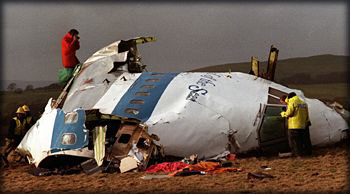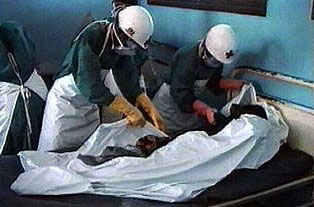|
Check out these books on Travel, Health and Transport Safety Tropical Diseases < Kidnapping |
Report by Roderick Eime Life is one of those things you miss most when it's gone. Travel is something Australians rather do for enjoyment but end up doing mainly for work. If we knew the real dangers of travel, would we be more likely to invite the neighbours over for scrabble and telecommute instead? Our lives are too often limited by our fears. We all know someone who is too afraid to fly. Others are too petrified to even leave their homes, the notion of travel only coming under "Verne, Jules". If we pay too much attention to the graphic evening news, we could believe that anything other than a quick and careful stroll to the corner shop in broad daylight is purely suicidal. Sure, life's a risk, but what are the real risks of taking a holiday or business trip? Let's look at the major travel dangers and their relative risks. Then we'll compare these with what we do around the home and at work - and you can make up your own mind.
These tend to make a big impression on us when they splash onto the TV news. They're always messy and very, very fatal. Horror movies and small screen dramas do nothing to enhance our comfort with these kerosene-powered, airborne behemoths, so let's put this fear into perspective. Your chances of surviving an aeroplane crash aren't any better than 50/50, even though you're very unlikely to be involved in one. Official US figures indicate a death rate of just .01 per billion passenger miles. Another British study shows that flying is 176 times safer than walking, 15 times safer than driving and 300 times safer than a motorbike. However, when you re-analyse these figures and display them according to hours exposed to a form of transport, cars and planes are about equal. Buses and trains, interestingly, are substantially safer under this method. Location and carrier are critical in determining how likely you are to arrive at your destination intact. CIS (ex-Soviet) airlines, of which there are now over 300, are the worst with a death rate ten times the global average. Africa and Asia, in that order, are the most dangerous places to fly, with South and Central America little better. Robert Young Pelton advises in his best selling book, The World's Most Dangerous Places , that you're best to avoid local carriers in China, North Korea, Colombia, all Central African countries and the former Soviet Union (CIS). Regardless of location; the smaller the plane, the higher the risk!
Even though you are much more likely to be involved in a ground level mishap, your chances of survival are better. We are constantly reminded about the dangers of personal vehicular transport, in particular the deadly ingredients of booze and bravado. If you think it's bad here, you'll be absolutely mortified at the figures coming from some countries. Look at studies performed by such groups as the IRF, NSC, and ASIRT, and in some places, you wouldn't get in a car for quids. Egypt, for one, has a death rate of 43.2 per 100 million kilometres driven. Other countries where motoring is more a way of death than way of life are Kenya (36), South Korea (29), Turkey (22) and Morocco (21). We might reckon the USA is the capital of death-on-wheels, but it actually rates very well under this method, at just 1.1, which is why you see this method quoted more there than anywhere else. Scandinavians take their safety seriously too, with similar ratings for each country there. Playing with statistics can be fun. Let's see who comes up trumps when we measure deaths per 100,000 of population. Statisticians call this the 'risk'. The winner: Malaysia at 31. South Korea (30.4), Portugal (28.1) and South Africa (26.5) all get a guernsey with Brazil, Hungary and Greece, each in the 22s, worth a dishonorable mention. Popular destinations for Aussie travellers like New Zealand (19.5) and USA (18.4) don't scrub up too well either in this light. Compare this to our national figure of just 9.3. While we're on a mathematical twist, we might as well look at the other key indicator used, namely the 'fatality rate'. This is derived from stiffs per 10,000 registered vehicles. Even though only about 50-odd people check out each year in the Central African Republic, it tops the scale at over 300. Africans have a serious death wish because Ethiopia and Malawi each chalk up nearly 200, while Tanzania, Botswana and Guinea all crack the 'ton'. Outside of the dark continent, Bangladesh (45), Kyrgyzstan (41), Syria, Burma (36) and China (26) also put their relatively few vehicles to very efficient use. Compare: Australia (1.8), USA (2.0), UK (1.5), Ireland (3.4) and NZ (2.2). Stop Press: Australian Transport Safety Bureau Report. January 7, 2003 As a general guide, countries (usually developing ones) with lots of people and relatively few cars have blood-curdling fatality rates (20+) as cavalier drivers try to assert their mechanical superiority over lowly pedestrians and cyclists on shithouse roads. Conversely, a country with a staggering 'rate' can still boast a low 'risk'. We call that 'safety in numbers'! Two forms of wheeled transport feature particularly highly in studies of road deaths - one, the motorcycle, and two, the minibus. The motorcycle in particular is the fastest means of transport to heaven, or hell as the case may be. Factors like poor road conditions, unfamiliar local traffic "customs" and a hearty disregard for personal safety add to near zero life expectancy once you climb aboard one of these two-wheeled deathtraps. About ten Australians will throw their lives away each year by this means. The minibus, according to Robert Young Pelton is "the most dangerous form of travel in the world." He argues that because these largely unregulated vehicles are run by largely unregulated entrepreneurs in similarly regulated countries, motor mayhem is unavoidable. These overloaded, overworked, undersized Japanese buzzboxes roar through crowded streets while their owners (or hirers) try to maximise their returns with scant regard for the bodycount. According to RYP, "in South Africa 60,000 accidents involving minibuses kill more than 900 people every year and 375 pedestrians were killed by the 30,000 or so minivans in Lima, Peru." The fare may be cheap, but so is life when you get into one of these pressed-metal caskets. Between thirty and forty Australians will die overseas each year as a result of some form of road-induced trauma, which, when you calculate per 100,000 travellers, equals a trifling 1.3.
Exotic Diseases
Images from the old black and white "scaries" loom. Boris Karlof, his putrid flesh dropping off in slabs, moans and groans as he drags himself from the crypt. Truth is, some of the worst diseases will make Karlof's Hollywood tribulations look like a kid's tea party. There's a frightening range of exotic diseases waiting to attack the unwary traveller, many able to cause rapid and painful death. Here is a roll-call of some of the worst.
Space prevents me from detailing the many more vivid afflications you can unwittingly acquire whilst travelling, but Bubonic Plague, Yellow Fever, Tetanus, Meningitis, Rabies and Leprosy make for entertaining study. According to Paul Prociv, Associate Professor in Medical Parasitology, University of Queensland, getting sick whilst overseas "can really stuff your life up, even it doesn't kill you!" Dr Provic, an expert in traveller's health, nevertheless rates death by exotic disease pretty unlucky. His studies show that around 10-15 travelling Australians will die each year by such cause, malaria being the most common.
Terrorism, as if we need reminding, is now a commonplace form of political expression. Bear in mind those at whom it is aimed only experience the "terrorism". To the perpetrators, it is always a "noble struggle against oppression." Kidnapping, on the other hand, is more a black industry. A crime committed by criminals for the express purpose of extracting as much money from your employer or family as possible. Sometimes the money goes to finance "terrorist" groups, but most often it just goes to gangsters. Americans, fortunately for the rest of the world, are the biggest targets for disgruntled foreign "operators" and "entrepreneurs", but Aussies employed by the Great Infidel might as well be draped in the same flag and are just as cheerfully lined up with their Yankee mates at curtain time. So choose your travelling companions carefully! Australians, as a consequence of our adventurous spirit and high disposable incomes, tend to land in remote, often dangerous locations. Our brave but dead thrillseekers have come home in boxes (and bags) from Indonesia, Cambodia, Africa, Yemen and South America. Another got out of Uganda by the skin of his teeth. Our bloke only released after Rwandan "rebels" butchered eight of his companions. Two Kiwis, for some unknown reason, were not spared. The Department of Foreign Affairs regularly lists countries and regions of major concern, and you should always acquaint yourself with local current affairs before you venture off on some expedition. When it comes to the crunch, your nationality is unlikely to save you from some crazed lunatic with a machete or AK-47. Some grab-facts from Dangerous Places: 200 foreign travellers are kidnapped every year. Only one in ten kidnappings are reported. The worst place in the world for kidnapping is Colombia, where ten people are snatched off the streets and from their beds every day. 40% of hostages are released after ransom is paid, 34% are rescued beforehand and 11% are released when kidnappers give up and throw you out. You don't want to know about the rest. According to DP's author, Robert Young Pelton, you are at greatest risk of death during a kidnapping episode at the beginning and/or the end. "At the outset, the terrorists typically are tense and high-strung and may behave irrationally. It is extremely important that you remain calm and alert and manage your own behaviour." Easily said! Botched rescue attempts account for most kidnapping deaths. According to Pelton, professional "consultants" lose about 2% of clients during "extraction", while local efforts are rather more expensive at around 9%. To avoid kidnapping, Pelton recommends that you should avoid suspect locations (which makes good sense). If you are staying somewhere shonky for a period of time, or working, you should vary your routine and even hire a local driver or bodyguard. Keep a low profile and don't seek attention. Other acts of terrorism like bombings and random shootings are impossible to predict, but if there is any intelligence about such matters, you'll find it at DFAT. Based on available data, around twenty Australians will be murdered whilst overseas each year. Although each circumstance is impossible to analyse, it is fair to say that many can be avoided if greater attention is paid to personal security.
According to DFAT's Director of Media Services, Tony Melville, you suffer about the same risk of death, from the same causes, travelling as you do at home. Perhaps this claim requires some clarification? Cancer, for example, is the largest killer of Australians, closely followed by heart disease. But very few Australians croak overseas from cancer on holiday or business. Heart attack, on the other hand, is the leading killer of travelling Australians. Roughly 75% of those deaths will be as a result of illness, either acquired or pre-existing. The rest will meet a violent end through accident, misadventure or other trauma. In 1992, 421 of the 2,300,000 travellers came home by unanticipated means (1 in 5463). In 1997 our cosmopolitan population rose to 2,933,000 and saw 590 of us return in the cargo hold (1 in 4971). In 1996, 460 Australians came home packaged from the 2,732,000 who took the risk (1 in 5939). According to Tourist Industry Trends, outbound short-term travel is increasing by at least 6% each year, but the tourist mortality rate is something nobody is prepared to guess at. Those with more experience than the author, suggest that the one-in-every-5000-something is a pretty typical figure, applicable to most years. Sure, we have good years and bad years, but if you fly Qantas (who have never lost a passenger) to established destinations, then your chances of arriving in good working order are much better than if you drive to work. When you consider the vast majority of accidents happen in and around the home, it may even be safer to stay travelling.
Don't travel without insurance. Cover your bags, your travel bookings, your health and your life. If you are at risk of kidnapping, some policies include what is known a KRE (kidnap, rescue and extraction). Study your destination. Know local customs and at least a little bit of the language. Find out where to go - and where NOT to go. Just because the locals scorch around without crash helmets and seat belts doesn't mean you should too. Take extra care crossing roads, and choose public transport carefully. Don't get pissed and try and drive/ride something. Never carry a gun, even when permitted to do so. You are more likely to get killed trying to use it than if you never had one. If your destination is that dangerous, hire a bodyguard. Consult a doctor or medical expert about your intended destination. Australians tend to travel without inoculations nowadays - not always a good idea, especially to many tropical countries. Be over-careful with personal hygiene and food. Water, salads and seafood are high-risk fare in many developing countries. Even cleaning your teeth can make you bloody crook!
|






